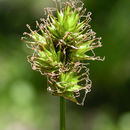Comments
provided by eFloras
Carex preslii has been synonymized with C. pachystachya (A. Cronquist 1969; C. L. Hitchcock and A. Cronquist 1973; A. Cronquist et al. 1972+).
- license
- cc-by-nc-sa-3.0
- copyright
- Missouri Botanical Garden, 4344 Shaw Boulevard, St. Louis, MO, 63110 USA
Description
provided by eFloras
Plants densely cespitose. Culms 23–56 cm. Leaves: sheath adaxially white-hyaline, summits U-shaped to rounded, often prolonged to 6 mm beyond collar; distal ligules 0.8–2.5(–4) mm; blades (2–)3–4 per fertile culm, 6–30 cm × 1.7–3.6 mm. Inflorescences dense or open, green and brown, gold, or brown, 1.4–3 cm × (5–)8–15 mm, stiff, appearing coarse-textured; proximal internode 3–7 mm; 2d internode 1–4 mm; proximal bracts usually aristate, shorter than inflorescences. Spikes 3–7, distant to loosely aggregated, usually individually distinct, narrowly to broadly ovoid, 7–10 × (3–)4.5–7.5 mm, base rounded or attenuate, apex usually acute. Pistillate scales white, gold, red-brown, or chestnut-brown, usually with pale to green midstripe, ovate to broadly ovate, 2.8–3.7 mm, shorter or longer and narrower than perigynia, margin occasionally white, 0.1–0.2(–0.5) mm wide, apex usually acute to acuminate. Perigynia appressed-ascending to ascending-spreading, green or gold, usually green toward beak, contrasting in color with pistillate scales, conspicuously 0–7-veined abaxially, conspicuously 0(–5)-veined adaxially, thin, ovate to broadly ovate, plano-convex or, more often, biconvex, (3.3–)3.5–4.3 × (1.3–)1.5–2 mm, 0.5–0.6(–0.8) mm thick, 2.1–2.7 times as long as wide, margin flat, including wing 0.2–0.4 mm wide, ciliate-serrulate at least on distal body, without metallic sheen; beak gold, gold-brown, red-brown, or brown at tip, flat, ± ciliate-serrulate or cylindric, unwinged, ± entire for 0.6 mm, abaxial suture usually inconspicuous, distance from beak tip to achene 1–2.4 mm. Achenes broadly oblong, ovate, broadly elliptic, or quadrate, 1.5–2 × 1–1.5 mm, 0.4–0.7 mm thick. 2n = 80.
- license
- cc-by-nc-sa-3.0
- copyright
- Missouri Botanical Garden, 4344 Shaw Boulevard, St. Louis, MO, 63110 USA
Distribution
provided by eFloras
Alta., B.C., Yukon; Alaska, Calif., Idaho, Mont., Oreg., Wash.
- license
- cc-by-nc-sa-3.0
- copyright
- Missouri Botanical Garden, 4344 Shaw Boulevard, St. Louis, MO, 63110 USA
Habitat
provided by eFloras
Open dry to seasonally dry areas; 1000–3400m.
- license
- cc-by-nc-sa-3.0
- copyright
- Missouri Botanical Garden, 4344 Shaw Boulevard, St. Louis, MO, 63110 USA
Comprehensive Description
provided by North American Flora
Carex preslii Steud. Syn. Cyp. 242. 1855
"Carex leporina L." Presl. Rel. Haenk. 1: 203. 1828.
In dense clumps, the rootstock short, much thickened, nearly corm-like, blackish, fibrillose, the culms 2.5-7.5 dm. high, slender but erect, strongly aphyllopodic, deep-green but lightbrownish at very base, exceeding leaves, roughened above on angles, making growth in one year, the leaves of the first year reduced to a few bladeless or very short-bladed, conspicuous, scale-like sheaths; leaves with well-developed blades usually 3 or 4 to a fertile culm, on lower third, sometimes more or less bunched towards base, the blades flat, deep-green, thinnish, usually 1.5-4.5 dm. long, 1.5-4 (usually 2-3) mm. wide, long-attenuate, the sheaths conspicuously white-hyaline ventrally, very thin, short-prolonged at mouth beyond base of blade and continuous with ligule; head oblong to globose, 10-20 mm. long, 6-10 mm. thick, containing 3—8 spikes, closely approximate, or the lower somewhat separated, usually readily distinguishable, gynaecandrous, ovoid or suborbicular, 5-8 mm. long and slightly narrower, rounded at apex, the lateral rounded and the terminal short-tapering at base, the 10-25 perigynia in many rows, with conspicuous spreading tips at maturity, the staminate flowers few, but the anthers often conspicuous; lower bracts usually but little prolonged, the upper scale-like; scales ovate, acute to mucronate, reddish-brown, with green midvein and narrowly hyaline margins, much narrower above and slightly narrower below and somewhat shorter than perigynia; perigynia plano-convex, ovate, 3.5-4 mm. long, 2 mm. wide (widest mar middle of achene), distended by the thick achene, deep-green at anthesis or yellowish-brown-tinged in age, strongly green-winged to base, obsoletely several -nerved dorsally, nerveless or sometimes obscurely nerved towards base ventrally, substipitate, rounded and spongy at base, subcoriaceous, strongly serrulate to middle of achene, abruptly contracted into a beak 1-1.5 mm. long, obliquely cut dorsally, non-hyaline, yellowish-brown-tipped, winged and serrulate to tip or nearly so, the tip slender or somewhat flattened, bidentate, the erect teeth closely Contiguous; achenes lenticular, oblong quadrate, 1.5 mm. long, 0.75 mm. wide, shortstipitate, apiculate; style deader, straight, jointed with achene, at length deciduous; stigmas two, slender, yellowish-brown.
Tvi-H LOCALITY 'of I'resl's "C. Irporinn I. ." oil which C. l'r,:tu i , 1, r , ,|.. " M.ib. in pOTtU Millgraave aul in '■
DiSTBiBtmoN Mountains, Alberta and Montana, and westward to British Columbia and ( all fornia. (Specimens examined from California, Oregon, Washington, British Columbia (including Vancouver Island), Idaho, Montana, Alberta.)
- bibliographic citation
- Kenneth Kent Mackenzie. 1931. (POALES); CYPERACEAE; CARICEAE. North American flora. vol 18(3). New York Botanical Garden, New York, NY

